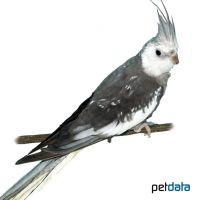Cockatiel Whitehead (Nymphicus hollandicus)
| Cockatiel Whitehead Nymphicus hollandicus | |
|---|---|
| Name | Cockatiel Whitehead |
| Name Lat. | Nymphicus hollandicus |
| Family | Cockatoos |
| Family lat. | Cacatuidae |
| Order | Parrots |
| Order lat. | Psittaciformes |
| Origin | Australia |
| Climate | Tropical |
| Diet | Large Parakeet seed, veggies, fruits |
| Keeping | Pair, group |
| Care Level | Easy |
| Reproduction | Cavity nest |
| Life Span | 15-20 years |
| Protection | No |
| Metric Units | |
| Size | 30 cm |
| Temperature | Room temperature |
| Housing | 200 x 100 x 100 cm |
| US Units | |
| Size | 12" |
| Temperature | Room temperature |
| Housing | 80" x 40" x 40" |
Distribution and habitat
The cockatiels are widespread in Australia. They live in pairs, in small groups and also in large flocks in the steppes, savannas and open grasslands but also as cultural followers. Today they are offered in many color mutations.
Cage size
The minimum cage size is 200 x 100 x 100 cm (L x W x H) for a pair. The cage size must not be undercut even in case of justified single keeping. For additional 2 birds, species compatibility provided, the floor space must be increased by 50%. The cage must be placed at a height of at least 80 cm (except aviaries) in a bright, draught-free, quiet place and should have cross-wiring or netting. Keeping in an aviary is preferable to keeping in a cage.
Maintenance
The floor must be covered with sand, wood shavings (untreated) or similar and must be cleaned regularly. At least 2 perches made of wood or branches of different thickness and height must be installed in such a way that the longest possible flight distances are created and contamination of the feed and water containers is prevented. Bathing facilities should be available at all times, alternatively they can be sprayed with water at least once a week. In addition to hiding places (sleeping boxes, sleeping baskets), they need climbing and occupation material, such as rings, ropes and natural branches that are harmless to health. They should be kept at room temperature.
Diet
The species-specific feed offer consists of mixed seeds, available in specialized trade as "cockatiel feed" in premium quality, supplemented with foxtail millet, green feed (dandelion, chickweed, green panicle millet), fruit (apples, pears, etc.).), vegetables (peppers, carrots, organic lettuce, etc.), fresh twigs with buds and, especially for raising young, germinated seeds (wheat or corn) and hard-boiled chicken egg mixed with large parakeet egg feed. As a digestive aid they need grit, cuttlefish and vitamin lime. Drinking water must always be available in birdbaths or in stable, open containers and, like food, must be offered fresh daily in clean containers. If there are several birds, several feeding stations should also be set up. A regular and varied diet promotes health and prevents deficiency symptoms.
Reproduction and breeding
As with many color mutations, the sex difference is difficult to discern and males and females are difficult to distinguish.
They breed in nest boxes in landscape or portrait. The clutch consists of 4-7 eggs, the incubation period lasts 19-21 days. Soft sawdust and bark mulch are suitable as nest box bedding. The breeding season is year-round, depending on biological conditions. Do not allow more than 2-3 broods per year! Young birds must be raised in such a way that they are species-specific. Hand rearing may only take place in justified exceptional cases
The average life expectancy can be 15-20 years.
Important
Cockatiels should be provided with a leg ring.
In the case of outdoor aviary keeping, they also need a heated shelter of at least 1 m², which can be visited by the birds at any time. The temperature in the shelter must not fall below 5 °C and the furnishings must correspond to those of cage keeping
They may only be kept in pairs or in a group. Socialization with other small parrots or finches is possible. In rooms, also in shelters, sufficient daylight or flicker-free artificial light (stroboscopic effect) corresponding to daylight must be provided. The lighting duration shall be 8-12 hours per day and the natural day-night rhythm shall be observed. Adequate indoor climate should be provided. If caged, they should be allowed free flight. The health condition of the birds should be checked daily.
Further literature can be found in your pet store.
References
Text: Othmar Sieberer; Image: petdata
Source: BMELV (1995): Tierschutzgutachten - Mindestanforderungen an die Haltung von Papageien; ARNDT (1997): Lexikon der Papageien, Arndt Verlag; GRUMMT & STREHLOW (2009): Zootierhaltung - Tiere in menschlicher Obhut: Vögel, Verlag Harri Deutsch
- Gemäß § 21 Abs. 5 Tierschutzgesetz idgF
